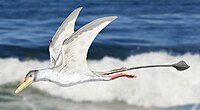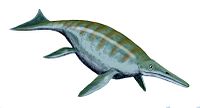Norian

 Clash Royale CLAN TAG#URR8PPP
Clash Royale CLAN TAG#URR8PPP System/ Period | Series/ Epoch | Stage/ Age | Age (Ma) | |
|---|---|---|---|---|
Jurassic | Lower/ Early | Hettangian | younger | |
Triassic | Upper/ Late | Rhaetian | 201.3 | ~208.5 |
Norian | ~208.5 | ~227 | ||
Carnian | ~227 | ~237 | ||
Middle | Ladinian | ~237 | ~242 | |
Anisian | ~242 | 247.2 | ||
| Lower/ Early | Olenekian | 247.2 | 251.2 | |
Induan | 251.2 | 251.902 | ||
Permian | Lopingian | Changhsingian | older | |
| Subdivision of the Triassic system according to the ICS, as of 2017.[1] | ||||
The Norian is a division of the Triassic geological period. It has the rank of an age (geochronology) or stage (chronostratigraphy). The Norian lasted from ~227 to 208.5 million years ago.[2] It was preceded by the Carnian and succeeded by the Rhaetian.[3]
Contents
1 Stratigraphic definitions
2 Palaeontology
2.1 Archosauromorphs
2.1.1 Archosaurs
2.1.1.1 Dinosauromorphs
2.1.1.1.1 Dinosaurs
2.1.1.2 †Pterosaurs
2.1.1.3 Crurotarsans
2.1.1.3.1 Crocodylomorphs
2.2 †Ichthyosaurs
2.3 †Placodonts
2.4 Mammalia
2.5 Temnospondyls
2.6 †Ammonites
3 References
3.1 Notes
3.2 Literature
4 External links
Stratigraphic definitions

Cast of a tridactyl footprint of a theropod dinosaur from the Norian of the Czech Republic.
The Norian was named after the Noric Alps in Austria. The stage was introduced into scientific literature by Austrian geologist Edmund Mojsisovics von Mojsvar in 1869.
The Norian stage begins at the base of the ammonite biozones of Klamathites macrolobatus and Stikinoceras kerri, and at the base of the conodont biozones of Metapolygnathus communisti and Metapolygnathus primitius. A global reference profile for the base (a GSSP) had in 2009 not yet been appointed.
The top of the Norian (the base of the Rhaetian) is at the first appearance of ammonite species Cochloceras amoenum. The base of the Rheatian is also close to the first appearance of conodont species Misikella spp. and Epigondolella mosheri and the radiolarid species Proparvicingula moniliformis.
In the Tethys domain, the Norian stage contains six ammonite biozones:
- zone of Halorites macer
- zone of Himavatites hogarti
- zone of Cyrtopleurites bicrenatus
- zone of Juvavites magnus
- zone of Malayites paulckei
- zone of Guembelites jandianus
Palaeontology
- Synapsids
- Aetosaurs
- Dicynodonts
- Phytosaurs
Archosauromorphs
Archosauromorphss of the Norian | ||||
|---|---|---|---|---|
| Taxa | Presence | Location | Description | Images |
| Löwenstein Formation; Trossingen Formation, both in Germany; Huai Hin Lat, Thailand; Fleming Fjord Formation, Greenland | |||
Archosaurs
Archosaurs of the Ladinian | ||||
|---|---|---|---|---|
| Taxa | Presence | Location | Description | Images |
| All across Europe | Zanclodon is the name formally used for fossil material that might actually belongs to at least two genera of dinosaur from the Late Triassic among other genera. | ||
Dinosauromorphs
Dinosauromorphs of the Norian | ||||
|---|---|---|---|---|
| Taxa | Presence | Location | Description | Images |
|  Dromomeron | |||
| New Mexico | |||
Dinosaurs
Dinosaurs of the Norian | ||||
|---|---|---|---|---|
| Taxa | Presence | Location | Description | Images |
| 208 Ma | Avon, England | A disputed dinosaur known from an ilium, maxilla, astragalus, and humerus (it could be a chimera). Agnosphitys lies close to the ancestry of dinosaurs, although exactly where is disputed by researchers. Some consider it a saurischian close to the beginnings of dinosaur evolution, while others consider it a non-dinosaurian dinosauromorph. |  Agnosphitys  Coelophysis  Eocursor  Liliensternus  Plateosaurus  Thecodontosaurus |
| Carnian to Norian | Chinle Formation, New Mexico, USA | ||
| Carnian to Norian | Chinle Formation, New Mexico and Arizona and Bull Canyon Formation, New Mexico | ||
| 210 Ma | South Africa | A swift-running basal ornithischian that has the most complete known remains from any Triassic ornithischian, shedding new light on the origin of this group. One of the earliest known ornithischians, it sheds some light on early dinosaur relationships because early dinosaurs are known from mostly incomplete skeletons. Eocursor is known from partial skeletal elements, including skull fragments, spinal elements, pelvis, long leg bones, and unusually large grasping hands. | |
| 228-201.3 Ma, Norian to Rhaetian | Trossingen Formation, Thuringia, Germany | A coelophysoid that is the best represented Triassic theropod from Europe and one of the largest known. | |
| 214-204 Ma, Carnian to Norian | Trossingen Formation, Bavaria, Germany | ||
| Norian to Rhaetian | |||
†Pterosaurs
Pterosaurs of the Norian | ||||
|---|---|---|---|---|
| Taxa | Presence | Location | Description | Images |
|  Eudimorphodon  Peteinosaurus  Preondactylus | |||
| ||||
| ||||
Crurotarsans
Crurotarsans of the Norian | ||||
|---|---|---|---|---|
| Taxa | Presence | Location | Description | Images |
| Lesotho |  Teratosaurus | ||
| ||||
Crocodylomorphs
Crocodylomorphs of the Norian | ||||
|---|---|---|---|---|
| Taxa | Presence | Location | Description | Images |
|  Saltoposuchus | |||
†Ichthyosaurs
Ichthyosaurs of the Norian | ||||
|---|---|---|---|---|
| Taxa | Presence | Location | Description | Images |
Shonisaurus
| Nevada, USA |  Shonisaurus | ||
†Placodonts
Placodonts of the Norian | ||||
|---|---|---|---|---|
| Taxa | Presence | Location | Description | Images |
|  Psephoderma | |||
Mammalia
Mammalia[4] of the Norian | ||||
|---|---|---|---|---|
| Taxa | Presence | Location | Description | Images |
|  Morganucodon | |||
| Norian to Sinemurian | Greenland and Western Europe | A Late Triassic-Early Jurassic kuehneotherian. | |
| ||||
| ||||
Temnospondyls
| †Temnospondyls of the Norian | ||||
|---|---|---|---|---|
| Taxa | Presence | Location | Description | Images |
| Arizona |  Apachesaurus | ||
| All over the USA and India | |||
†Ammonites

Pinacoceras layeri
- Acanthinites
- Pinacoceras layeri
References
Notes
^ http://www.stratigraphy.org/index.php/ics-chart-timescale
^ According to Gradstein et al. (2004). Brack et al. (2005) give 226 to 207 million years
^ See for a detailed geologic timescale Gradstein et al. (2004)
^ The genera listed are included in Mammalia by Kielan-Jaworowska et al. (2004) but not by those who restrict the taxon to the crown group.
Literature
Brack, P.; Rieber, H.; Nicora, A. & Mundil, R.; 2005: The Global boundary Stratotype Section and Point (GSSP) of the Ladinian Stage (Middle Triassic) at Bagolino (Southern Alps, Northern Italy) and its implications for the Triassic time scale, Episodes 28(4), pp. 233–244.
Gradstein, F.M.; Ogg, J.G. & Smith, A.G.; 2004: A Geologic Time Scale 2004, Cambridge University Press.
Kielan-Jaworowska, Z.; Cifelli, R. L.; Luo, Zhe-Xi; 2004: Mammals from the Age of Dinosaurs, Columbia University Press.
Martz, J.W.; 2008: Lithostratigraphy, chemostratigraphy, and vertebrate biostratigraphy of the Dockum Group (Upper Triassic), of southern Garza County, West Texas, Doctoral Dissertation, Texas Tech.
External links
- GeoWhen Database - Norian
Upper Triassic timescale, at the website of the subcommission for stratigraphic information of the ICS- Norges Network of offshore records of geology and stratigraphy: Stratigraphic charts for the Triassic, [1] and [2]